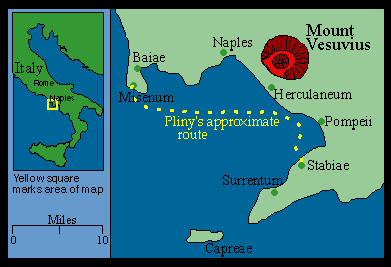








The History of Pompeii
The city of Pompeii was an ancient Roman town-city located in Italy, near modern Naples. The city of Pompeii was destroyed in the volcanic eruption of Mount Vesuvius in 79 A.D. With an estimated population of 20,000 people the city was filled with wonderful architecture and artifacts. Sadly, with the eruption of Mount Vesuvius two thousand people died and the city was buried under a thick layer of ash for years (History.com).
Discovered by a group of explores in 1748, in the excavation site "Civita" it was amazing to see that the city though covered in ash was still intact. It is still possible to see all the buildings, artifacts, and all the citizens of Pompeii still preserved in their last moments before death (History.com).
 |  |  |
|---|---|---|
 |  |

Created By:
Luis Guerra
Phillip Hassel
Sara Gordon
Sanya Jeffrey
The Golden Bracelet of Pompeii
Gold with glass paste eyes
On the River Sarno, Muregine
Inside, this armband is inscribed:
DOMINUS ANCILLAE SUAE ‘From the
master to his slave’.
Some of the jewellery that were discovered in Pompeii looked remarkably modern in design andvaried widely in quality and material (“People like us: An incredible insight into the Romans who died in Pompeii's horror” by Rachael Bletchly).
Engagement rings were more common than wedding bands, children had charm bracelets and snake bangles were in style (“People like us: An incredible insight into the Romans who died in Pompeii's horror” by Rachael Bletchly).
The referrence to the snake bracelet the snake was a frequent motif on gold jewelry during the Hellenistic and Roman periods (The NaturalHistory of Pompeii edited by Wilhelmina Feemster Jashemski, Frederick G. Meyer).
The Colubrids snake was viewed as a house pet by the Romans. They were welcomed into the home to eat pests such as mice and other rodents. The Colubrids-type snakes are used as models for some of the jewelry found in Pompeii ("The NaturalHistory of Pompeii" edited by Wilhelmina Feemster Jashemski, Frederick G. Meyer).
Snakes are omnipresent in the archeological evidence of Pompeii. Rare as exact representations of actual species, they exist more often as symbols of religious forces the Pompeians wished to propitiate and understand ("The NaturalHistory of Pompeii" edited by Wilhelmina Feemster Jashemski, Frederick G. Meyer).
Usually when a slave got this arm band it was to symbolize that they had been presented a new status in their community. Either meaning they were favored by the masters or involved in extra marital affairs with these woman which was a very comon occurance..
This bracelet was a sign of ownership in ones slave and also showing a large amount of affection, by giving this arm band or bracelet people would know the significance of this bracelet.

 |  |
|---|---|
 |

Archaeologists have found evidence of a bag containing sophisticated jewellery. The jewellery was found with the remains of a man and a woman who had been trying to escape from a hotel as Vesuvius erupted in 79 AD ("Pompeii dig reveals gift to ex-slave girl" By Bruce Johnston in Rome).
It has been interrupted that the two individuals had to be a couple of both master (dominus) and his female slave (ancilla), turned-lover. "Dominus suae ancillae" was the inscription on one gold bracelet in the form of a snake, which weighed a pound and had diamonds for eyes ("Pompeii dig reveals gift to ex-slave girl" By Bruce Johnston in Rome).
Gold and precious stone earrings, necklaces, bracelets and rings were common adornments on women. Men wore rings, but rarely any other jewellery. Beautiful jewellery not only enhanced the wearer’s appearance but also proclaimed his or her social status. It would have
been very unusual for a slave girl to have such a beautiful piece of jewellery.
